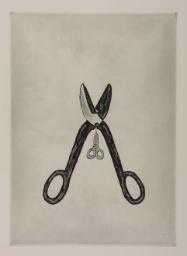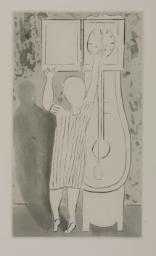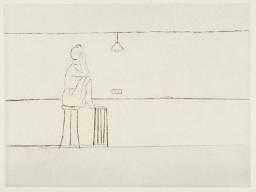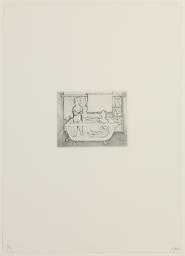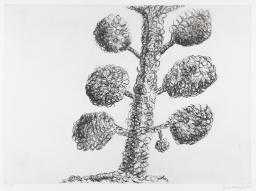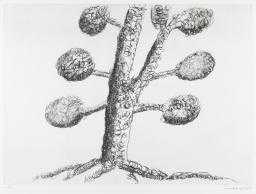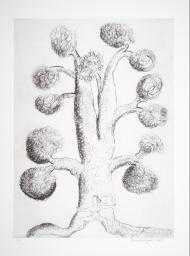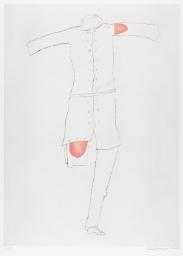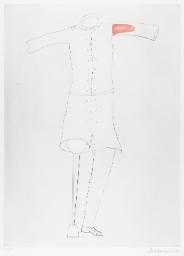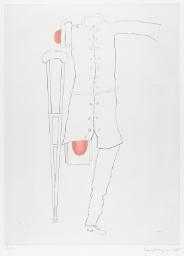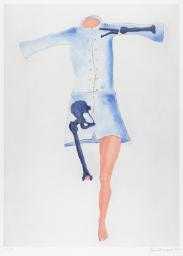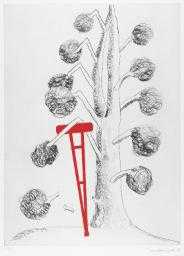
In Tate Britain
Prints and Drawings Room
View by appointment- Artist
- Louise Bourgeois 1911–2010
- Medium
- Etching, drypoint and aquatint on paper
- Dimensions
- Image: 760 × 553 mm
- Collection
- Tate
- Acquisition
- Purchased 2002
- Reference
- P78624
Summary
Topiary: The Art of Improving Nature is a suite of nine copperplate etchings with dry point and aquatint presented in a salmon pink silk-covered box. The portfolio was produced in an edition of twenty-eight of which this is the twelfth. It was printed by Harlan and Weaver, New York and published by Julie Sylvester Cabot, Whitney Museum of American Art Editions, New York. The prints follow a progression and are individually numbered and titled with a simple description. IV Tree with Shoes depicts two huge shoes planted firmly at the bottom of the page. Trunk-like legs emerge from them bristling with a forest of branches which fill the upper half of the page. One shoe is low-heeled and sensible; the other is high-heeled and ornamented with laces. Tree with Shoes represents a development of the first three images in which a growing tree, I Tree (P78621) and II Tree with Split Trunk (P78622), becomes a mature woman, III Tree with Woman
(P78623). The image evokes the infant’s view, from ground level, of his or her mother’s feet and legs towering above. The small branches and twigs covering them from the ankle up protect the tree-woman’s body from exposure to the viewer’s eye. The image of the tree returns in the final image of the portfolio, IX Tree with Crutch (P78629).
Bourgeois’ work is based on memory, particularly that of her early years in France. Conflicting feelings arising from the complex dynamics of her parental relationships and her experiences of moving away from home and becoming a mother have been the inspiration for her art for over sixty years. Drawing has been a central means of expression, usually in series and with a diaristic function. Bourgeois first took up printmaking in 1938, the year she moved to New York with her husband the American art historian Robert Goldwater (1907-73). After producing an important series, He Disappeared into Complete Silence in 1947, she abandoned printmaking in 1949, only to return to it in 1973, the year Goldwater died. Since the late 1980s, Bourgeois has produced several portfolios, including the Autobiographical Series 1994 (Tate P77682-P77695).
Topiary: The Art of Improving Nature develops several characteristic themes of Bourgeois’ art. Trees and plants, with anthropomorphic resonances, appear in some of her earliest paintings and drawings. She has referred to a plant or a tree as ‘a symbol of a person ... It has a right to exist, to grow and to procreate’ (Bourgeois, p.124). Emotional damage and the resulting necessary strategies for self-defence and repair are fundamental concerns for Bourgeois, who applies geometry, representing rationalism, to anxiety in a process which she has labelled ‘the art of fighting depression (emotional dependence)’ (Bourgeois, p.167). In Topiary, the crutch which appears in VII Amputee with Crutch (P78627) and IX Tree with Crutch (P78629), is drawn with the straight lines of a ruler, its geometric regularity contrasting with the organic forms of the tree and the woman’s body.
Figures with amputated limbs, present in her sculptures since the early 1990s, stem from early memories of war veterans at the Louvre Museum in Paris, where she worked as a guide to the Exposition Universelle in 1937. The sight of them unselfconsciously stuffing themselves with food in the canteen filled her with horror. The imagery of amputated limbs resurfaced in her work over forty years later. The image of a crippled woman, developed in prints V Amputee (P78625), VI Amputee with Peg Leg (P78626) and VII Amputee with Crutch (P78627), also stems from a closer relationship. Bourgeois’ sister Henriette suffered from a condition which stiffened her leg, forcing her to walk with a cane. A sculpture made in tribute to her, Henriette 1985 (Robert Miller Gallery, New York), is a ‘peg leg’ of the sort depicted in print VI.
Colours are important emotional registers for Bourgeois. She has stated: ‘Blue represents peace, meditation and escape. Red is an affirmation at any cost – regardless of the dangers in fighting – of contraction, of aggression. It’s symbolic of the intensity of the emotions involved ... Pink is feminine. It represents a liking and acceptance of the self.’ (Bourgeois, p.222.) Bourgeois’ spare use of colour in Topiary has dramatic effect in contrast to the predominant pale grey and black of the portfolio. Significantly, the brightest colour is the red of the crutch in the final image. Topiary, the art of clipping and training of plants into ornamental forms, represents an intervention on natural growth. Bourgeois’ title referring to ‘improvement’ employs her characteristic sarcastic humour to subvert a subject traditional to female identity, the acculturation of ‘woman as nature’. Often represented historically as horizontal landscape and allied with the earth, in Topiary, woman is portrayed as vertical – rooted in the earth but reaching up into the sky. The amputation imagery indicates that the ‘improvement’ may involve more dramatic mutilation than mere snipping and shaping. Bourgeois has emphasised that making art is her means of psychic survival (Bourgeois pp.222-30). In the final image of the portfolio, the red crutch is both a means of support and a source of damage, suggesting an ambiguous relationship with methods for self-protection, self-defence and survival.
Topiary IV 1999 (Jerry Gorovoy, New York) is a sculpture encapsulating the imagery of the print portfolio.
Further reading:
Louise Bourgeois at the Hermitage, exhibition catalogue, State Hermitage Museum, Saint Petersburg 2001, p.75
Louise Bourgeois, Marie-Louise Bernadac, Hans-Ulrich Obrist, Destruction of the Father/Reconstruction of the Father: Writings and Interviews 1923-1997, London 1998
Deborah Wye, Carol Smith, The Prints of Louise Bourgeois, exhibition catalogue, The Museum of Modern Art, New York 1994
Elizabeth Manchester
May 2003
Does this text contain inaccurate information or language that you feel we should improve or change? We would like to hear from you.
Explore
- abstraction(8,615)
-
- from recognisable sources(3,634)
-
- organic(827)
- garden structures(1,939)
-
- topiary(27)
- clothing and personal items(5,879)
-
- shoe(179)
- social comment(6,584)
-
- gender(1,689)
- gender(33)
You might like
-
Louise Bourgeois Triptych for the Red Room
1994 -
Louise Bourgeois Scissors
1994 -
Louise Bourgeois Woman and Clock
1994 -
Louise Bourgeois Woman in Bathtub
1994 -
Louise Bourgeois Empty Nest
1994 -
Louise Bourgeois Woman with Suitcase
1994 -
Louise Bourgeois Children in Tub
1994 -
Louise Bourgeois Tree
1998 -
Louise Bourgeois Tree with Trunk
1998 -
Louise Bourgeois Tree with Woman
1998 -
Louise Bourgeois Amputee
1998 -
Louise Bourgeois Amputee with Peg Leg
1998 -
Louise Bourgeois Amputee with Crutch
1998 -
Louise Bourgeois Blue Dress
1998 -
Louise Bourgeois Tree with Red Crutch
1998


